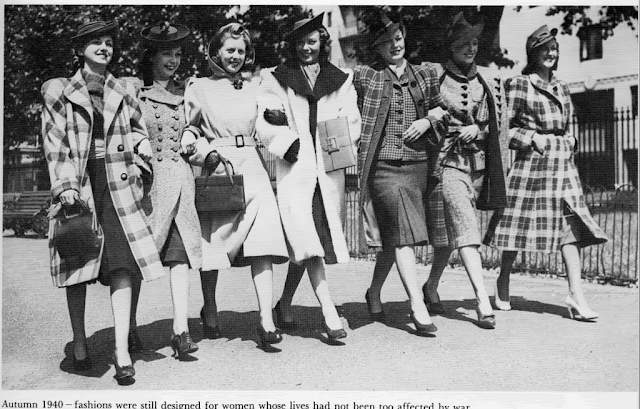To say I was a bit late with my sewing for my son's First Communion would be a huge understatement. I was hoping too long the event would be postponed due to the pandemic. Then, as usual, I had to hurry. A lot. Two weeks for two outfits was a bit tight... Especially when you have two kids and a challenging teenage dog! Picking a project for myself usually is not a problem. Tons of patterns, tons of fabrics. But as my daughter is a little miss now, she needed something nice to wear too. But as she is not a small girl anymore and not yet a proper miss, it's not easy to find the right thing. Luckily she is growing a lot, also character-wise. (She's half a head shorter than me, and she's 12.)
So this time no pink, no dress. Instead she was very excited when I showed her the 1930s Wearing History Beach Pajama pattern - a pattern I adore myself as well! She picked a viscose (rayon) javanaise, and then it was a rather short knock-off. I have done a lot of shirring on baby and toddler clothing, no issue there, I only had to down-size the pattern. She also loves the Gertie wrap tops I made in various versions from Butterick 6285 for myself, and this too was a quick job after the down-grading was done. I usually don't double the top, but make it from a single layer only, which makes it less bulky for the summery versions and saves a considerable amount of fabric. Even though the both patterns represent two different eras, I think they make a lovely combination for a young girl not (yet) into vintage properly, but certainly outside the average frame. And I had one very happy girl.
Having a soft spot for all things Irish (my son's name is Irish), I have been looking a long time for a lovely clover or shamrock themed fabric that is not too childish. Shortly after Christmas until St Patrick's Day in March you find a lot of rather cheap, colourful or clumsy shamrock prints, but I wanted something more decent and "grown-up". A couple of weeks ago I found an online seller in my country I had not heard of before. Browsing through their site I came a cross this extraordinary viscose fabric with a clover print, Swiss made, and significantly reduced. It was just meant to be! (So far to my decision to reduce my stash.) I originally bought it with another project in mind, but when I had to chose the material for my dress, my husband suggested this would be perfect.
First I thought I would make the 1942 two-piece dress from Eva Dress Patterns, originally Du Barry 5510. But I know all too well that I probably would never wear the skirt separately with a different top, so I rather spontaneously turned the wrap blouse into the bodice of a wrap dress, combining it with the skirt part of Simplicity 1710 from 1946. I have gained a lot of weight during the last couple of months, due to the pandemic and the hormones, and wrap dresses are so forgiving and comfortable. No matter what size or shape you are! I always wanted to make this pattern, but I don't like bust darts that start at the waist line. I also took the fluttery sleeves from the Simplicity dress and changed the gathered skirt inset into a pleated one to match thew pleats on the shoulders. I will probably have to add a pressure stud on the skirt, as I almost had a Marilyn moment. In front of the church certainly not funny.
The fabric, as any other viscose javanaise or challis, was very challenging, certainly not for beginners, a nightmare to cut and sew, but is a dream to wear. And to my utter surprise, it doesn't wrinkle half as much as all my other viscose or rayon fabrics do! Yay to a domestic product in an outstanding quality at an unbeatable price! It has the soft and almost peachy touch of certain silks and a wonderful drape. Sadly the weather wasn't improving as I had hoped - this is probably the coldest April I can remember. Obviously I needed something to cover my bare arms. I looked at many of my patterns, and this Du Barry 5908 from 1944 was the most simple 40s jacket I could find. (Size 12 only - anybody else hates upgrading vintage patterns?) I wished I had a green fabric at hand, but the only matching material was a beige and rather bland noil silk* I had bought about 20 years ago in a fabric shop in Zurich that has closed down long ago. I think it was a colour I love back then. And I realised once again how much of a fabric hoarder I am.
This unlined little number came together easily, but I should have shortened it by about one inch to end just at the waist line. Maybe later. The entire project had a lot of hand stitching (and some night-sifts) involved, all the hems on both garments are done manually. Luckily my husband was very helpful, and he knows now very well how to handle our laundry-machine. Instead of wrapping bands I added presser studs to the bodice, and I made a belt with a perfectly matching vintage bakelite belt buckle. The buckle was still on its original card, and it matches the focal bead on the bakelite necklace I was wearing, even though the other beads look bit darker. I'm happy I made some shoulder pads for the dress. I have rather square shoulders, and most garments fit quite nicely without them, but the the pads just add that tiny bit for a better fit.
The mid-century shamrock brooch is probably a bit too much, but I so wanted to wear it on that special day, honouring my son on this occasion.



























































